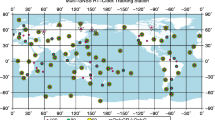Abstract
Because the signals of global positioning system (GPS) satellites are susceptible to obstructions in urban environment with many high buildings around, the number of GPS useful satellites is usually less than six. In this case, the receiver autonomous integrity monitoring (RAIM) method cannot exclude faulty satellite. In order to improve the performance of RAIM method and obtain the reliable positioning results with five satellites, the series of receiver clock bias (RCB) is regarded as one useful satellite and used to aid RAIM method. From the point of nonlinear series, a grey-Markov model for predicting the RCB series based on grey theory and Markov chain is presented. And then the model is used for aiding RAIM method in order to exclude faulty satellite. Experimental results demonstrate that the prediction model is fit for predicting the RCB series, and with the clock-based RAIM method the faulty satellite can be correctly excluded and the positioning precision of GPS receiver can be improved for the case where there are only five useful satellites.
Similar content being viewed by others
References
HU Hai-dong, HUANG Xian-lin, LI Ming-ming, SONG Zhuo-yue. Federated unscented particle filtering algorithm for SINS/CNS/GPS system [J]. Journal of Central South University of Technology, 2010, 17(4): 778–785.
ZHANG Jian-jun, YUAN Hong. Analysis of unmanned aerial vehicle navigation and height control system based on GPS [J]. Journal of Systems Engineering and Electronics, 2010, 21(4): 643–649.
CHEN Yu-bo, SONG Ying-chun. A Bayes filter algorithm with non-Gaussian noises based on location of vehicular GPS [J]. Journal of Central South University: Science and Technology, 2010, 41(4): 1462–1466. (in Chinese)
TONG Xiao-hua, WU Song-chun, WU Shu-qing, LIU Da-jie. A novel vehicle navigation map matching algorithm based on fuzzy logic and its application [J]. Journal of Central South University of Technology, 2005, 12(2): 214–219.
WU Fu-mei, NIE Jian-liang, HE Zheng-bin. Low-cost GPS/INS integrated navigation algorithm in land vehicle system considering attitude update [J]. Journal of Chinese Inertial Technology, 2010, 18(6): 675–679. (in Chinese)
BLANCH J, WALTER T, ENGE P. RAIM with optimal integrity and continuity allocations under multiple failures [J]. IEEE Trans on Aerospace and Electronic Systems, 2010, 46(3): 1235–1247.
YANG Chuan-sen, XU Xiao-hao, LIU Rui-hua, ZHAO Hong-sheng. New algorithm for receiver autonomous integrity monitoring [J]. Transactions of Nanjing University of Aeronautics & Astronautics, 2010, 27(2): 155–161.
WANG Jin-ling, OBER P B. On the availability of fault detection and exclusion in GNSS receiver autonomous integrity monitoring [J]. Journal of Navigation, 2009, 62(2): 251–261.
LIU Wen-xiang, LI Zheng-rong, WANG Fei-xue. A new RAIM method for detecting and correcting weak pseudo-range bias under gradual change [J]. Journal of Astronautics, 2011, 31(4): 1024–1029. (in Chinese)
HEWITSON S, WANG Jin-ling. Extended receiver autonomous integrity monitoring (eRAIM) for GNSS/INS integration [J]. Journal of Surveying Engineering, 2010, 136(1): 13–22.
GUO Rui, ZHANG Jian-ting, FENG Lai-ping, YANG Zhen. Analysis of RAIM availability and its performance under pseudolite-aided condition [J]. Progress in Astronomy, 2009, 27(1): 89–97. (in Chinese)
LEE Y C. Investigation of extending receiver autonomous integrity monitoring (RAIM) to combined use of Galileo and modernized GPS [C]// Proceedings of the 17th International Technical Meeting of the Satellite Division of the Institute of Navigation. Long Beach, USA, 2004: 1691–1698.
BEDNARZ S, MISRA P. Receiver clock-based integrity monitoring for GPS precision approaches [J]. IEEE Trans on Aerospace and Electronic Systems, 2006, 42(2): 636–642.
FOULY E L, SAADANY E L, SALAMA M M. Grey predictor for wind energy conversion systems output power prediction [J]. IEEE Trans on Power Systems, 2006, 21(3): 1450–1452.
SU S F, LIN C B, HSU Y T. A high precision global prediction approach based on local prediction approaches [J]. IEEE Trans on Systems, Man and Cybernetic, 2002, 32(4): 416–425.
Author information
Authors and Affiliations
Corresponding author
Additional information
Foundation item: Project(20090580013) supported by the Aeronautic Science Foundation of China; Project(ZYGX2010J119) supported by the Fundamental Research Funds for the Central Universities, China
Rights and permissions
About this article
Cite this article
Teng, Yl., Shi, Yb. Clock-based RAIM method and its application in GPS receiver positioning. J. Cent. South Univ. Technol. 19, 1558–1563 (2012). https://doi.org/10.1007/s11771-012-1176-1
Received:
Accepted:
Published:
Issue Date:
DOI: https://doi.org/10.1007/s11771-012-1176-1




